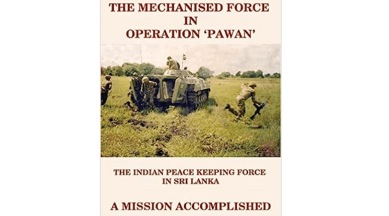Stay updated with the latest - Click here to follow us on Instagram
Military Digest: Mechanised forces in Operation Pawan in Sri Lanka: an appraisal
The difficulties experienced by the mechanised forces while taking part in the IPKF operations, the successes achieved by them, and the vital lessons learnt from the various setbacks and failure of planning by higher commanders have been documented in a new book The Mechanised Force in Op Pawan.

The employment of mechanised forces in the Indian Peace Keeping Force (IPKF) in Sri Lanka and the question of their effectiveness have not been much discussed in open forums. The induction of armour and mechanised infantry was initially for peacekeeping operations but it soon devolved into full-blown counter-insurgency operations.
The difficulties experienced by the mechanised forces while taking part in the IPKF operations, the successes achieved by them, and the vital lessons learnt from the various setbacks and failure of planning by higher commanders have been documented in a new book The Mechanised Force in Op Pawan.
In his book, Col Sidhu points out how in the initial stages the IPKF was actively ranged against the Sri Lankan Army and was, in fact, providing operational cover to LTTE and its leadership. The Infantry Combat Vehicles (ICVs) of the mechanised forces played a vital role in checkmating the Sri Lankan Army deployment on several occasions, he says.
According to the book, at one time, in August 1987, four ICVs were deployed to transport the LTTE supremo V Prabhakaran along with his family from the Palaly airfield to Jaffna University. Several ICVs were used to picket the route for this movement, it adds.
The author says the initial employment of the mechanised battalions in penny pockets of a few BMPs here and there dissipated their potency. He points out, “Even the operational grouping with infantry battalions and brigade headquarters was in terms of ICVs rather than sub-units. This psyche of the command hierarchy resulted in relegating one of the most potent fighting arms to the status of support arm even before intense military operations had commenced against the LTTE”.
The apparent lack of planning for the induction of IPKF as well as mechanised forces not only reflected in the manner in which the fighting was done with LTTE hut it also got exposed in the logistical support which was to be given to the fighting formations, says the book. The weak logistics support and the over-exploitation of the tracked vehicles with little regard to their maintenance problems was something which had not been figured out by the higher leadership of the Army, it adds.
“The mechanised forces were inducted without the back up from the integral services units of the armoured formation…..As an example, of the three T-72 tanks under Major Anil Kaul grouped with the task force to extricate 10 Para Commando team from Jaffna University, only one tank reached the objective and that too with a malfunctioning main gun,” the author writes.
Col Sidhu says after the initial employment of armour and mechanised infantry battalions in penny pockets and as mobile pill boxes, a saner decision was finally taken to form mechanised task forces. This turned out to be a successful method of conducting operations against the LTTE, he adds.
The book points out that in the latter phase of operations in Jaffna and Mullaitivu regions, mechanised infantry and armour were regrouped into task forces and the coordinated employment of massed firepower and cross-country manoeuvres, in conjunction with infantry, created problems for the LTTE and enabled the capture of key localities with minimum casualties.
The book has first-hand accounts from participants in the mechanised operations apart from dozens of good-quality photographs and some detailed coloured maps of the operational area. There is one interesting incident, early on in the induction of IPKF in Sri Lanka, recounted in the book which brings out the farcical nature of the ill-planned induction operations which began one way and ended a very different way.
In October 1987, the book says, the Sri Lankan Navy captured 17 senior LTTE cadres, including Pulendran and Kumarappa (commanders of Batticaloa and Trincomalee regions of LTTE), off the Jaffna coastline. These men were kept prisoners in the air control tower at Palaly airfield by the Sri Lankan Army. The Indian Army’s 54 Infantry division deployed para commandos and other troops around the tower to prevent the Sri Lankan Army from taking these LTTE cadres to Colombo.
In retaliation, the Sri Lankan Army formed another cordon around the 54 Infantry Divisions’ troops using armoured cars. This was followed by the 54 Infantry Division retorted by deploying the BMPs of a mechanised battalion to form yet another cordon around the Sri Lankan armoured cars. Eventually, all 17 LTTE cadres consumed cyanide and 12, including Pulendran and Kumarappa, were killed.